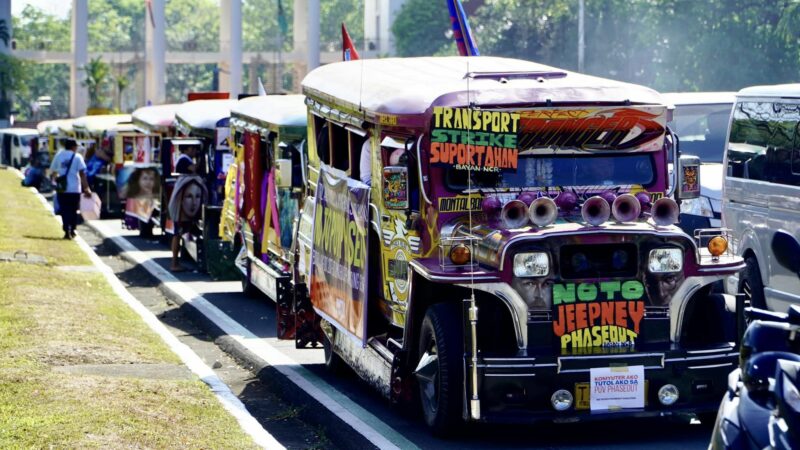 [1]
[1]Jeepney strike in Quezon City, Metro Manila. Photo [1] from Kodao, a content partner of Global Voices.
Filipino jeepney drivers, operators, and their supporters conducted a two-day transport strike to protest the government’s modernization program, which critics said would lead to the phaseout of the iconic Philippine-made vehicle.
After World War II, Filipinos modified the surplus vehicles left behind by American military troops who were stationed there and turned them into jeepneys [2] which became a popular mode of public transportation across the country. Many have since been decorated and revamped in colorful paint and patterns, and are considered an essential part of Philipines transport for both residents and tourists alike.

A jeepney in Legazpi City. Via Wikipedia [3], license (CC BY-SA 4.0) [4]
The strike was supposed to last for a week, but organizers ended the protest on the second day (March 7) after the office of the Philippine president met transport leaders and said the government would commit to reviewing the modernization program and consult all stakeholders.
In 2017, the Department of Transportation (DOTr) launched [5] its Public Utility Vehicle (PUV) Modernization Program, which proposed replacing traditional jeepneys with a modern version that is “safe, reliable, convenient, and environmentally sustainable.”
Transport groups insisted that they are not against modernization, but they said that the timeline of the government would displace many jeepney drivers and operators who are unable to consolidate or form a cooperative. Furthermore, they appealed for subsidies because the majority of drivers cannot afford to buy a modern vehicle to replace the traditional jeepneys. PISTON, one of the strike organizers, reiterated their position:
“Who would not want a more efficient and comfortable vehicle? We earn barely enough to survive. We’d like a modernisation that caters to the needs of the transport sector. But this is modernisation that favours big business and is a bane to the commuting public as well,”
— PISTON (@pistonph) March 8, 2023 [6]
The government announcement of a June 30, 2023 deadline for the jeepney phaseout led transport groups to declare a strike.
In response, the DOTr extended the deadline for another six months. But transport groups vowed to continue with the protest as they asked Philippine President Ferdinand Marcos Jr. to listen to their demands.
In anticipation of the strike, schools and offices announced the shift to online operations. Government vehicles were also deployed to offer free rides to stranded passengers.
Transport groups in the country’s main urban centers widely participated [7] in and supported the two-day strike. It also received the support of activists and concerned citizens who criticized the government’s modernization scheme for being anti-poor. The multisectoral No to PUV Phaseout Coalition issued this statement in support of the strike [8]:
The fight of drivers and small operators also belongs to the people. Without a franchise, operators will lose their livelihoods. Drivers will have no jeepneys to use. Millions will have to endure the lack of access to affordable transportation.
Some legislators also asked the government to review [9] and reconsider its so-called modernization program. Senator Chiz Escudero asked [10] about the rationale for replacing jeepneys with vehicles from China and Russia.
There are no safeguards whatsoever with respect to the affected drivers and operators who will be displaced because of this supposed modernization. The Philippines is known for its jeepneys and all of a sudden, overnight, they want to phase it out and replacing it with these square looking buses from China and Russia?
Vice President Sara Duterte, who is also the education secretary, lambasted [11] the “communist-inspired” strike for disrupting the learning recovery of students. In response, the Alliance of Concerned Teachers explained why many public school teachers are supporting the strike [12].
Many of our students and teachers have family members who are PUV drivers who are about to lose their livelihood. Our difficult realities and the scantiness of government funding for education are the real serious impediments to education recovery, so much more than the coming transport strike.
As the protest entered its second day, the office of President Marcos reached out [13] to the strike leaders and held a dialogue. Marcos said later in a media interview that the government will ensure the livelihood [14] and welfare of jeepney drivers.
Transport groups declared the strike a success [15], but they vowed to continue the campaign against the planned phaseout of jeepneys.